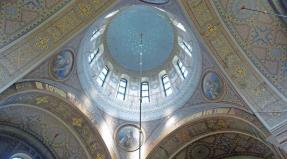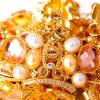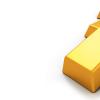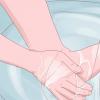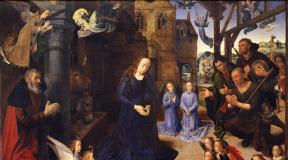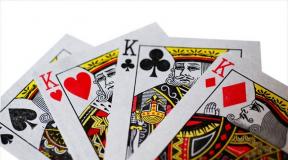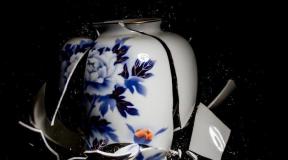Exaltation of the church feast of signs. Exaltation of the cross of the lord - holiday traditions and what not to do on this day
The Exaltation is one of the great church events. So that troubles and failures pass you by, observe the traditions and signs of the holiday.
Every year on September 27, the Orthodox Church recalls an event that took place many years ago in Jerusalem - the miraculous uncovering of the Cross on which Jesus Christ was crucified.
In addition to the Exaltation of the Cross, a folk holiday is also celebrated on this day - the end of Indian summer, or the Third Autumn. Therefore, many traditions and signs of the holiday are not only religious, but also folk in nature.

Traditions of the Exaltation of the Cross
Like any other church holiday, the main tradition for the Exaltation is visiting temples and churches, listening to divine liturgies. A religious procession takes place in many cities. On this day, they prayed for the healing of loved ones, for a rich harvest next year, asked for deliverance from sins.
The cross is a special Orthodox relic that symbolizes suffering. Therefore, a strict fast should be observed on this day. Previously, it was believed that the one who neglects this tradition, God punishes seven sins, and from the one who did not taste the meager food, he removes seven sins.
It was believed that prayers on this day have special power. If on this day you sincerely pray or ask for something, it will certainly be fulfilled.
It was forbidden to serve any meat dishes on this holiday. It was believed that a person who tasted the meat of a killed animal on this day kills all the prayers he uttered.
According to folk traditions, on September 27 it was forbidden to go to the forest. It was believed that on this day Leshy walks through the forest and counts all the forest inhabitants, and if a person gets on his way, the traveler will not find the way back from the forest.
The cross symbolizes divine protection. In ancient times, those who wanted to protect their home and their loved ones, on September 27, painted a cross on the doors of their home. This tradition exists in our time.
For the peasants, this day was considered the final end of Indian summer and the onset of autumn. By this time, all matters related to agriculture should be completed.

Signs of the Exaltation of the Cross of the Lord
Both for believers and for those who are far from religion, signs were very important on this day. And many random things acquired a sacred meaning.
September 27 is the last day of Indian summer. It was believed that autumn was beginning to move towards winter.
In Russia, on this day, a folk holiday was celebrated - cabbage. The women who served cabbage pies were considered good housewives. Young girls and boys gathered on this day for festivities, girls laid the table, and the guys chose their brides.
On September 27, many signs foreshadowed the onset of cold weather: birds flew south, bears lay down in their den, and snakes hid in a hole.
Believers always put spiritual meaning in Orthodox holidays. The Exaltation of the Cross of the Lord along with Easter and the Nativity of Christ has a special meaning for Christians. If you also honor this great event, do not forget to observe the traditions and signs of the holiday, and then happiness will not pass you by. Peace to you and your home, and don't forget to press the buttons and
25.09.2017 07:19
Many folk festivals were dedicated to seasonal phenomena and events. And even the beginning of autumn and farewell to ...
Tuesday, September 26, 2017 19:51 + in the quote pad
The Exaltation of the Holy Cross is a holiday celebrated by the Orthodox Church on September 27. On this day, believers remember how the Cross was miraculously found in Jerusalem in 326, on which Jesus Christ was crucified. We will tell you about the events, meaning and traditions of the Exaltation of the Cross.
What is the Exaltation of the Cross of the Lord

The full name of the holiday is the Exaltation of the Honorable and Life-giving Cross of the Lord. On this day, Orthodox Christians remember two events.
According to Holy Tradition, the Cross was acquired in 326 in Jerusalem. It happened near Mount Golgotha, where the Savior was crucified.
And the second event is the return of the Life-giving Cross from Persia, where he was in captivity. In the 7th century, he was returned to Jerusalem by the Greek emperor Heraclius.
Both events were united by the fact that the Cross was raised before the people, that is, raised. At the same time, they turned him to all parts of the world in turn, so that people could bow to him and share with each other the joy of finding a shrine.
The Exaltation of the Cross of the Lord is a twelve feast day. The twelve feasts are dogmatically closely related to the events of the earthly life of the Lord Jesus Christ and the Mother of God and are divided into Lord's (dedicated to the Lord Jesus Christ) and Theotokos (dedicated to the Mother of God). Exaltation of the Cross is a feast of the Lord.
When the Exaltation of the Cross of the Lord is celebrated

The Russian Orthodox Church recalls the Exaltation of the Lord's Cross on September 27, new style (September 14, old style).
This holiday has one day of forefeast and seven days of afterfeast. Forefeast - one or several days before a big holiday, the services of which already include prayers dedicated to the upcoming celebrated event. Accordingly, afterfeast is the same days after the holiday.
The giving of the holiday is October 4th. The giving of the feast is the last day of some important Orthodox holidays, celebrated with a special service, more solemn than on the usual days of the afterfeast.
What can you eat on the feast of the Exaltation of the Holy Cross
On this day, the Orthodox have strict fasting. You cannot eat meat, fish, eggs and dairy products. Food can only be seasoned with vegetable oil.
Events of the Exaltation of the Cross

Description of the events of the Exaltation of the Cross of the Lord, which took place in the IV century, we find in some Christian historians, for example, Eusebius and Theodoret.
In 326, Emperor Constantine the Great decided at all costs to find the lost shrine - the Cross of the Lord. Together with his mother, Queen Helena, he went on a campaign to the Holy Land.
It was decided to carry out excavations near Calvary, since the Jews had a custom of burying the instruments of execution near the place of execution. And, indeed, in the ground they found three crosses, nails and a board that was nailed over the head of the crucified Savior. As Tradition says, a sick person touched one of the crosses and was healed. So Emperor Constantine and Empress Helena learned which of the crosses was the same. They bowed to the shrine, and then the Patriarch Macarius of Jerusalem began to show it to the people. To do this, he stood on a dais and raised ("erected") the Cross. People worshiped the Cross and prayed: "Lord, have mercy!"
QuoteIn the 7th century, another memory was combined with the memory of the discovery of the Lord's Cross - about the return of the Tree of the Life-giving Cross of the Lord from Persian captivity.
In 614, the Persian king conquered Jerusalem and sacked it. Among other treasures, he took to Persia the Tree of the Life-giving Cross of the Lord. The shrine stayed with foreigners for fourteen years. Only in 628 the emperor Heraclius defeated the Persians, made peace with them and returned the Cross to Jerusalem.
Historians do not know exactly how the further fate of the shrine developed. Someone says that the Cross was in Jerusalem until 1245. Someone that was cut into pieces and smashed around the world.
Now part of the Cross of the Lord rests in the ark in the altar of the Greek Church of the Resurrection in Jerusalem.
History of the Feast of the Exaltation of the Holy Cross

According to Tradition, the Cross of the Lord was acquired before the holiday of Easter, the Bright Resurrection of Christ. Therefore, at first, the Exaltation of the Cross was celebrated on the second day of Easter.
In 335, the Church of the Resurrection of Christ was consecrated in Jerusalem. It happened on September 13th. In honor of this, the Feast of the Exaltation was postponed to September 14 (according to the old style; according to the new style - September 27). Bishops who came to the consecration from all over the Roman Empire told the whole Christian world about the new holiday.
Divine service of the Exaltation of the Holy Cross

On the day of the Exaltation of the Cross, it is supposed to celebrate the All-night Vigil and the Liturgy. But now they rarely serve all night, so the festive Divine Service on the eve of the holiday - vigil - becomes the centerpiece.
Exaltation is the Lord's (dedicated to the Lord Jesus Christ) twelve feast day. Therefore, his service does not connect to any other service. For example, the memory of John Chrysostom is transferred to another day.
It is interesting that during Matins for the Exaltation of the Cross, the Gospel is read not in the middle of the church, but in the altar.
The culmination of the holiday is when the chief priest or bishop, dressed in purple vestments, carries the Cross. All worshipers in the church kiss the shrine, and the primate anoints them with holy oil. During the general worship of the Cross, the troparion is sung: "We worship Your Cross, O Lord, and we glorify Your holy resurrection."
The cross lies on the lectern until October 4 - the day of the giving of the Exaltation. For giving, the priest takes the cross to the altar.
Prayers for the Exaltation of the Holy Cross

Troparion of the Exaltation of the Holy Cross
Save, Lord, Thy people and bless Thy heritage, giving victories by Orthodox Christians to resisting and preserving Thy residence by the Cross.
Transfer:
Save, O Lord, Thy people and bless Thy inheritance, granting victories to the faithful over enemies and preserving Thy people with Thy Cross.
Kontakion of the Exaltation of the Holy Cross
Ascended to the Cross by the will of the same name as Your new habitation, grant Your generosity, Christ God, rejoice your faithful people with Your power, giving us victories for comparison, an aid to those who have Your weapon of peace, an invincible victory.
Transfer:
Ascended to the Cross voluntarily, to a new people of the same name, grant Thy mercies, Christ God; rejoice in Thy strength Thy faithful people, giving us victories over enemies, to help those who have from You, the weapon of peace, an invincible victory.
The Exaltation of the Exaltation of the Cross of the Lord
We magnify Thee, the Life-Giving Christ, and we honor Thy Holy Cross, and you saved us from the work of the enemy.
Prayers to the Honest and Life-giving Cross of the Lord
First prayer
The Honest cross, the guardian of the soul and body, wake me up: casting down demons in your image, driving away enemies, exercising passions and giving me reverence, both life and strength, with the assistance of the Holy Spirit and honest prayers of the Most Pure Theotokos. Amen.
Second prayer
O Most Holy and Life-giving Cross of the Lord! Anciently, you were a shameful instrument of execution, but now is the sign of our salvation ever revered and glorified! How worthy can I, unworthy, glorify Thee, and how dare I bow the knee of my heart before my Redeemer, confessing my sins! But the mercy and unspeakable philanthropy of the humble Boldness that is crucified upon you gives me, may I open my mouth to glorify Thee; For this, for the sake of Ty cry: Rejoice, the Cross, the Church of Christ is the beauty and foundation, the whole universe is the affirmation, Christians of all are the hope, the kings are the power, the faithful are refuge, the Angels are glory and praise, the demons are fear, destruction and driving away, the wicked and the unfaithful - shame, the righteous - delight, the burdened - weak, overwhelmed - a refuge, the lost - a mentor, obsessed with passions - repentance, the poor - enrichment, the floating - the helmsman, the weak - strength, in battle - victory and conquest, the orphan - faithful protection, widows - intercessor, virgins - protection for chastity, hopeless - hope, sick - doctor and the dead - resurrection! Thou art represented by the miraculous rod of Moses, the life-giving source, which nourishes the thirsty for spiritual life and delights our sorrows; You are a bed, on which the Resurrected Conqueror of Hell rested royally for three days. For this sake, both morning and evening and noon, I glorify Thee, the Treasured Tree, and I pray by the will of the Crucified One on Thee, that He enlightens and strengthens my mind with You, that He may open in my heart the source of love more perfect, and all my deeds and my journey will overshadow You. Yes, I will magnify the One Nailed to You, my sin for the sake of my Lord Savior. Amen.
Icon of the Exaltation of the Holy Cross

The most widespread theme of the icon of the Exaltation of the Holy Cross took shape in Russian icon painting in the 15th-16th centuries. The icon painter depicts a large crowd of people against the background of a single-domed church. In the center of the pulpit stands the Patriarch with the Cross raised above his head. Deacons support him under his arms. The cross is decorated with sprigs of plants. In the foreground are the saints and everyone who came to venerate the shrine. On the right are the figures of Tsar Constantine and Tsarina Helena.

Icon. XVIII century. From the festive row of the iconostasis of the church in the village of Selezenikha, Tver region. State Institute of Restoration, Moscow.
Folk traditions and signs of the Feast of the Exaltation of the Cross
In Russia, the feast of the Exaltation of the Holy Life-giving Cross of the Lord combined church and folk traditions.
On this day, peasants painted crosses on the doors of houses, put small wooden crosses in a manger for cows and horses. If there was no cross, it was replaced by crossed rowan branches.
September 27 was also called the third Osenins or Stavrov day. It was the final day of Indian summer, the third and last meeting of autumn.
"Exaltation is in the yard, the last shock from the field is moving, the last cart is in a hurry to the threshing floor!"
“The fur coat for the caftan stretches to the Exaltation!”
"On the Exaltation, a zipun with a fur coat will move!"
"The exaltation of the caftan will sweep away, the fur coat will be put on!"
"Exaltation - the last cart has moved from the field, and the bird - in flight!"
The day was fast:
"Whoever fasts on the Exaltation, seven sins will be forgiven,"
"Even though the Exaltation will come on Sunday, and everything on it is Friday-Wednesday, fast food!"
"He who does not fast with the Exaltation - the Cross of Christ - on him will be raised up seven sins!"
The Feast of the Exaltation was also called "cabbage".
"Dare, woman, about the cabbage - Movement has come!"
"Movement-cabbage, it's time to chop the cabbage!"
"Now and then chop the cabbage that from the Vdvizhenie!"
"A good man has cabbage pies for Vzdvizhenye day!"
"On Vzdvizhenie, the first lady is cabbage!"
They also said:
"Neither Vozdvizhenskaya nor Annunciation cabbage beats frost!"
Young people arranged "Kapustensky evenings"; they lasted two weeks.
On the day of the Exaltation, there are many prohibitions that help to avoid trouble. Keeping the precepts of the ancestors and the precepts of the church will help everyone to bring prosperity into life and receive the protection of heaven.
You can do the necessary household chores: washing, cooking, cleaning, washing dishes and bathing. The Church does not prohibit such events if they are really necessary. For example, there are sick relatives in the home who require care or small children.
On the day of the holiday, it is customary to bring three candles from the church, go around the corners of the house, connecting the candles together, and read a protective prayer.
On the Exaltation, holy water has powerful healing properties. She can wash and give seriously ill people to drink so that they get better.

Holiday bans
You can not start new cases that may be losing or it will be impossible to complete them for various reasons.
It is forbidden to eat products of animal origin.
It is worth giving up entertainment, watching entertainment programs.
According to the precepts of the ancestors, there was no way to the forest on that day - the animals were preparing for hibernation, and they could not be disturbed.
You can't scold, indulge negative emotions and enter into conflicts.
It is worth giving up needlework and work with the land.
On the day of the holiday, the necessary cases are not prohibited, but the clergy urge to remember that the day is intended for prayer and spiritual growth. On the 27th, you can gather with the whole family, visit the church and thank the Higher Forces for their help and patronage.
On September 27, the Orthodox Church celebrates the great twelveth holiday - the Exaltation of the Cross of the Lord. It is dedicated to two important events related to the Cross on which Jesus Christ was crucified. This is the acquisition of the Cross, which took place in the 4th century thanks to the efforts of Saint Helena (mother of Constantine the Great) and then, three centuries later, the deliverance of the shrine from the "Persian captivity" by Emperor Heraclius.
Exaltation of the Cross of the Lord: traditions and customs of the day
The people said: “ On the Exaltation, the heat will move, and the cold will move. On the Exaltation, autumn moves faster towards winter". And indeed, by this time, real autumn had come: the sun was shining, but no longer warming with its warmth, a cold, gusty wind was blowing, birds fly off to warm regions, and people took out warm things from chests. On this day, the third meeting of autumn takes place and the Indian summer comes to an end.
According to popular legend, on September 27, a battle takes place between “ honor"And" wickedness", One on top of the other two forces rise (" erect "):" holy "and" unholy ", truth and falsehood. With the help of the Holy Cross of the Lord that has risen from the depths of the earth, truth wins the victory. Since the Cross is a symbol of suffering, the people considered the day of the Exaltation of the Lord's Cross to be fast.
This day was also called "Stavrov Day" (translated from Greek "cross"). For a long time, on this church holiday, processions of the cross were performed around the villages in order to protect them from troubles for a year. They served a prayer service, walked around the fields with icons, asking the Lord for the future harvest. They also prayed for the sick. They believed that if you pray with faith, then the Life-giving Cross will rise from the deathbed.
It was customary to raise crosses on churches under construction, to build chapels and small churches in honor of the holiday. The peasants put crosses carved from wood or simply rowan branches folded crosswise in the bins, the bush and in the manger to the cow. In the old days, in order to protect their home, livestock and the harvested crop from troubles, crosses were burned on the door lintel and on the barn gates.
There was a belief that on the Feast of the Exaltation one should not start any important and significant deeds, because everything started on this day will either be useless and unsuccessful, or end in complete failure.
Our ancestors noticed that on this holiday, reptiles go to some unknown warm lands, and swallows fly away with them. For this reason, people carefully locked the gates, gates and doors for the whole day so that the bastards crawling into the vyryu did not crawl into the courtyard by mistake, and they tried not to go into the forest on the Exaltation.
 This day was dangerous for hiking in the forest, not only because of snakes, but also because of werewolves, goblin and other evil spirits. According to legend, the goblin gathered in one place the animals they controlled for inspection before the coming winter. They could harm the person they met.
This day was dangerous for hiking in the forest, not only because of snakes, but also because of werewolves, goblin and other evil spirits. According to legend, the goblin gathered in one place the animals they controlled for inspection before the coming winter. They could harm the person they met.

In addition to the devil, this day was also important for the barn - the spirit who lives in the barn and takes the form of the owner of the house. On September 27, the "barn name days" were celebrated. Ovin was not allowed to drown that day. The threshers did not work either. If the sheaves had already been placed in the barn, the owner pretended to unload it by taking out the two upper sheaves. The hostesses spread an embroidered towel on the barn window, and left a treat to the barn owner for the night.

The third meeting of autumn - "Skit"
From this date a series of merry autumn parties began - "cabbage", "skits", which lasted two weeks. They were celebrated not only by residents of villages and villages, but also by townspeople. The girls, dressed in elegant colored clothes, went from house to house to chop cabbage. Single men were looking for brides for themselves.
In the evening, when the cabbage was chopped up, real fun began, which quite often led to weddings played on Pokrov. To win the heart of the guy they liked, the girls read a special conspiracy.
Neighbors and acquaintances were invited to such parties. The woman, entering the house, congratulated the owners on the cabbage harvest. They brewed beer and baked pies for the guests. The evening ended with songs and dances.
September 27: signs and beliefs
- If the geese fly high - to a large high water, if low - to a small one.
- The north wind is blowing - the summer will be warm.
- If the serpent bites a person during the Exaltation, then it will not crawl to warm lands. She will have to freeze in the winter cold.
- Frosts in the morning - by early winter.
- If the weather is clear and warm, the cold won't come soon.
- Sharply colder - spring will be early.
- North wind - for a hot summer.
- Having seen a flock of migratory birds, you need to ask them to say hello to deceased relatives.
- Girls cannot go to the forest, because the goblin can steal.
- On the Exaltation, one cannot pass by places where a murder was once committed - an unclean person can beguiled.
- Seeing incomprehensible footprints on the ground, you cannot cross them. These footprints may belong to forest scum. Whoever crosses them will soon become seriously ill.
- A person who is lost in the forest on this day must take off his clothes, shake them and read a prayer. It is believed that this will help him find his way faster and save him from meeting the devil.
To a person born 27 September, given the ability to artistic creativity. He should wear amethyst .
Assessment
We tried to reveal all the important moments of this Orthodox holiday, celebrated by Orthodox believers on September 27. For our readers who are interested in what kind of holiday, we inform you that this most important date in Orthodox Christianity falls on September 27 - one of the 12 main, or twelve, holidays of the Orthodox Church.
It was installed in memory of the uncovering of the Lord's Cross, which, according to church tradition, took place in 326 in Jerusalem near Mount Calvary - the site of the Crucifixion of Jesus Christ.

September 27 - holiday
The full name of the holiday is the Exaltation of the Honorable and Life-giving Cross of the Lord. On this day, Orthodox Christians remember two events. According to Holy Tradition, the Cross was acquired in 326 in Jerusalem. It happened near Mount Golgotha, where the Savior was crucified. And the second event is the return of the Life-giving Cross from Persia, where he was in captivity. In the 7th century, he was returned to Jerusalem by the Greek emperor Heraclius. Both events were united by the fact that the Cross was raised before the people, that is, raised. At the same time, they turned him to all parts of the world in turn, so that people could bow to him and share with each other the joy of finding a shrine.

Folk signsfeast of the Exaltation of the Cross of the Lord
Like any holiday or important date, on the Exaltation of the Life-giving Cross of the Lord on September 27, a lot of attention was also paid to signs. Some signs of the Exaltation of the Lord's Cross on September 27 are now perceived ambiguously. Moreover, there are those whose context is not even clear, because the realities of life are now categorically different from our ancestors. In any case, we recommend reading the Exaltation of the Cross of the Lord.

- Dare, woman, about cabbage - Exaltation has come!
- On the Exaltation, the first lady is cabbage!
- On the Exaltation, the caftan with the fur coat moved, and the cap pulled down.
- Whoever does not fast with the Exaltation - the Cross of Christ - upon him seven sins will be raised up!
- Even though the Exaltation will come on Sunday, and everything on it is Friday-Wednesday, fast food!
- On the Exaltation - autumn moves faster towards winter.
- The last birds go to the Exaltation for wintering.
- On the Exaltation of the door to the lock so that the bastards do not get into the house.
- Whoever goes to the Exaltation into the forest will be lost.
- Do not start any important business - everything will go to dust.
- Deliver the house from evil spirits at the Exaltation.

Exaltation of the Cross of the Lord: What not to do
You have already understood what the feast of the Exaltation of the Lord's Cross means. As with another important holiday of the Orthodox calendar, there are restrictions on what you can and cannot do on that day. Read on about what is forbidden for Exaltation.

Prohibitions on the Orthodox holiday of the Exaltation of the Cross of the Lord primarily relate to going into the forest:
- It is believed that it is on this day that "snakes and reptiles go to the ground." Whoever goes to the forest that day will be lost.
- On this day, the doors must not be left open so that the "bastards" do not crawl into the house in search of a warm wintering place;
- There was a belief: do not start any important business at the Exaltation - everything will go to dust;
- On the day of the Exaltation of the Holy Cross, you cannot eat dairy and meat products, observing a strict fast.

Icon
Also, many are interested in the Exaltation of the Cross of the Lord, the icon helps in what. The Exaltation of the Cross icon describes the finding of the Holy Cross by Queen Helena, on which Jesus Christ was crucified. After the Crucifixion, Resurrection and Ascension of the Lord, the instrument of torture of the Savior was lost. Queen Helena, mother of the Emperor Constantine the Great, managed to find him only in 326 after an exhausting search. The Icon of the Exaltation of the Cross is known for its miraculous powers. After sincere prayer to the Holy Cross, illnesses recede.

